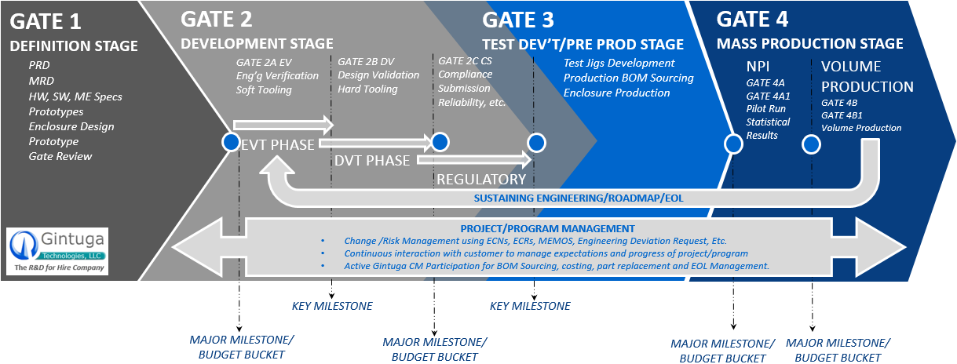Product Development Life Cycle
Before a product may be thrusted into its various life cycle stages, it has to be developed. Product development is naturally a crucial part of any manufacturing process. Most organizations are aware that all products have a limited lifespan, and so new and up-to-date products are to be developed to replace them and to keep the company in business


Gate 1:
Definition Stage
Focuses on defining the product requirements (What will the product be?)
- > Product Requirements Document
- > Marketing Requirements Document
- > Hardware | Software | Mechanical Specifications
- > Engineering Derived Specifications
- > Prototypes Enclosure Design Softtooling

Gate 2:
Development Stage
This gate has three stages:
-
Gate 2A
Engineering Verification Phase (EVP)
Focuses on the functionality of the product (Are the features feasible by adapting or using existing available technologies or do we need to innovate a new implementation?)
-
Gate 2B
Design Validation Phase (DVP)
Focuses on the robustness of the product (Are the features robust, reliable & can be manufactured?) Build larger than EVP units for statistical parametric validation testing, quality factor and production test specification determination
-
Gate 2C
Compliance
Focuses on regulatory pre-compliance and compliance testing of the product making sure that the product regulatory requirements are met or approvals are acquired prior to mass production. Build regulatory grade units for compliance submission. Document preparation for compliance submission

Gate 3:
Pre-Production Stage
Focuses on making sure that the Development-For-Manufacture (DFM) and Development-For-Test (DFT) checklists are verified in preparation for production. This includes test software automation development, test jigs design and development, test plan creation, etc.

Gate 4:
Production Stage
This gate has two stages:
-
Gate 3A
New Product Introduction (NPI)
Conducts product pilot run, build regulatory certified grade first articles, fine-tune assembly and test runs
-
Gate 3B
Mass Production
Focuses on product volume production

Sustaining Engineering
There are no perfect products.
There will be items that may be missed as there will be not enough data or time to do what is required or wanted to be done in a given time. Sustaining engineering is the mechanism to continually improve the product until End Of Life (EOL).
 We are not just your supplier. We are your partner. When we exceed your expectations, we have met our own.
We are not just your supplier. We are your partner. When we exceed your expectations, we have met our own. 

The Research and Design
For Hire Company